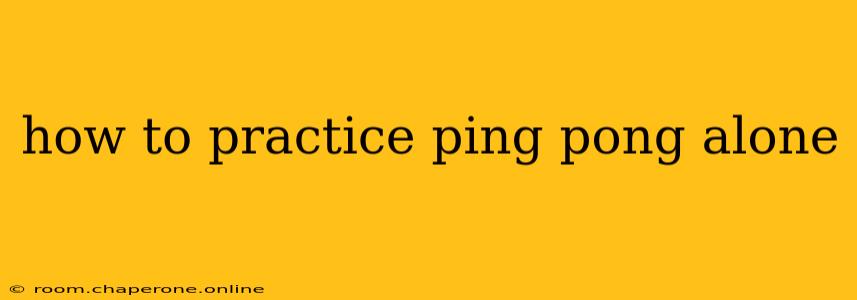Practicing ping pong alone might seem counterintuitive, but it's a surprisingly effective way to improve your skills. While playing against an opponent provides invaluable match experience, solo drills allow you to focus on specific techniques and build muscle memory. This guide provides a comprehensive approach to solo ping pong practice, covering everything from basic drills to advanced techniques.
Mastering the Fundamentals: Basic Solo Drills
Before diving into advanced techniques, solidifying your fundamental skills is crucial. These drills are perfect for beginners and experienced players looking to refine their basics:
1. Forehand and Backhand Drills:
- Wall Practice: This classic drill involves hitting the ball against a wall, focusing on consistent contact and controlled strokes. Vary the distance from the wall to adjust the difficulty. Aim for consistent placement and speed. Pay close attention to your grip and follow-through.
- Single-Hand Drills: Practice your forehand and backhand separately, focusing on each stroke's technique. Concentrate on proper footwork, grip, and the transfer of weight. Aim for consistent, controlled shots.
2. Serving Practice:
- Variety is Key: Practice different types of serves – topspin, backspin, sidespin – to develop versatility and surprise your opponents in future matches. Aim for accuracy and consistency in placement.
- Serve Placement: Focus on hitting specific areas of the table, like the corners or close to the net. This helps develop precision and control.
3. Footwork Drills:
- Shadow Practice: Simulate playing a point without the ball, focusing on your footwork patterns. Practice moving quickly and efficiently to cover the table.
- Step-and-Hit Drills: Practice stepping into your shots, especially on serves and returns, improving your power and control.
Advanced Solo Training: Elevating Your Game
Once you've mastered the basics, you can move on to more advanced drills to refine your skills:
1. Advanced Stroke Drills:
- Spin Variation: Practice incorporating different amounts of spin onto your shots to make them more unpredictable. This involves subtle adjustments in your wrist and grip.
- Short Game Drills: Practice short shots, focusing on delicate touches and precise placement. This is vital for controlling rallies and setting up offensive opportunities.
2. Mental Game Practice:
- Visualization: Close your eyes and visualize yourself playing perfect points. This mental rehearsal can significantly improve your performance under pressure.
- Self-Analysis: Record yourself playing (even just the drills), and then review the footage to identify areas for improvement in your technique and strategy.
3. Utilizing Training Aids:
While not strictly solo, certain training aids can enhance your individual practice:
- Robotic Ball Machines: These machines can provide a constant stream of balls at varying speeds and spins, allowing for focused practice on specific strokes.
- Training Apps: Numerous apps provide interactive drills and feedback, enhancing the learning experience.
Creating a Structured Practice Plan
Consistency is key. Create a structured practice plan, scheduling regular sessions, focusing on specific areas for improvement. A typical session might involve 15-20 minutes on each skill area, with a short warm-up and cool-down. Remember to listen to your body and take breaks as needed. Regular, focused solo practice significantly improves your ping pong skills. Even 30 minutes a couple of times a week can significantly improve your game.
Conclusion: Unlock Your Ping Pong Potential
Solo ping pong practice is a fantastic way to improve your game. By diligently focusing on the fundamentals and gradually incorporating advanced techniques, you can significantly elevate your skill level. So grab your paddle, find a wall, or set up your training aids, and start your journey to ping pong mastery!

